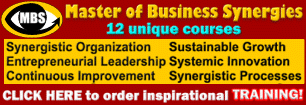|
Your Operational Excellence |
by Vadim Kotelnikov & Ten3 East-West
|
Yourself & Your Team ► Your Cross-Functional Excellence |
Your Organization ► Establishing Institutional Excellence |
Your Processes ► Sustainable Competitive Advantage Total Quality Management (TQM) ► Managing Intellectual Assets |
|
When to Apply Operational Excellence Programs? A program to enhance operational excellence makes the best sense when there are significant opportunities to improve by bringing the underperformers up to the level of the best-performers within a given business paradigm. "This is the focus of most best-practices programs: stop reinventing the wheel and make sure that everyone, everywhere is operating with the best available knowledge."8 Keep in mind however, that without a proper differentiation strategy, mastering operational effectiveness alone is not enough to win the marketplace. Leadership in operational costs of production that allow for low prices is very difficult to sustain. Price wars are very dangerous, so avoid them wherever possible. Continuous Improvement Firm (CIF) CIF is a firm continuously improving on customer value due to improvements in productivity initiated by the members of the general work force. Productivity in CIF is broadly defined to include all facets of product quality as well as output per worker. A basic operating principle of the CIF is that improvements in product quality often produce simultaneous reductions in costs. The key success factor in this endogenous, incremental and continuous technological and operational change is the organization and management of the firm in such a way that all members are motivated to promote change and are supported in their effort to do so. What is remarkable about the CIF is its ability to operate simultaneously in all innovative arenas: new products, new technology, new organizational forms, and new customer relationship management...More Six Sigma Six Sigma is a long-term, forward-thinking initiative designed to fundamentally change the way corporations do business. It is first and foremost "a business process that enables companies to increase profits dramatically by streamlining operations, improving quality, and eliminating defects or mistakes in everything a company does. While traditional quality programs have focused on detecting and correcting defects, Six Sigma encompasses something broader: It provides specific methods to re-create the process itself so that defects are never produced in the first place...More Lean Production Lean is about doing more with less: less time, inventory, space people and money. Lean Manufacturing (also known as the Toyota Production System) is, in its most basic form, the systematic elimination of waste - overproduction, waiting, transportation, inventory, motion, over-processing, defective units - and the implementation of the concepts of continuous flow and customer pull. Five areas drive lean manufacturing/production: cost, quality, delivery, safety, and morale. Just as mass production is recognized as the production system of the 20th century, lean production is viewed as the production system of the 21st century... MoreCleaner Production Cleaner production processes are those that produce less waste, whether in terms of liquid wastes discharged to waterways, solid wastes going to landfill or gaseous wastes discharged to the air. Many companies have achieved environmental and economic benefits by implementing cleaner production programs...More Kaizen - the Japanese Concept of Effective Management Kaizen strategy calling for never-ending effort for improvement at all organizational levels, is the most important Japanese management concept and the key to the country's competitive advantage. Kaizen concentrates at improving the process rather than at achieving certain results. Such managerial attitudes make a major difference in how an organization masters change and achieves improvements... More Case in Point: General Electric GE used to reward success in an unusual way. If an executive and his or her team exceeded their objectives they were challenged, the next year, to meet tougher goals with fewer resources and smaller budget. Those who experienced this hard practical school have learned how to achieve more with less. Case in Point: Dell Computer Corporation "To motivate an employee to think like an owner, you have to give her metric she can embrace," says Michael Dell, CEO of Dell Computer Corporation. "At Dell, every employee's incentives and compensation are tied to the health of the business. We explained specifically how everyone could contribute: by reducing cycle times, eliminating scrap and waste, selling more, forecasting accurately, scaling operating expenses, increasing inventory turns, collecting accounts receivables efficiently, and doing things right the first time. And we make it the core of our incentive program for all employees."10 |
Bibliography:
-
"Liberation Management", Tom Peters, 1994
-
"The Project Manager's MBA", by D.J. Cohen and R.J. Graham, 2001
-
"ICB - IPMA Competence Baseline", by International Project Management Association (IPMA), 1999
-
"Extreme Management", Mark Stevens, 2001
-
"Relentless Growth", Christopher Meyer, 1998
-
"Leading Change", James O'Toole, 1996
-
"It's not the BIG and eats the SMALL... it's the FAST that eats the SLOW", Jason Jennings and Laurence Haughton, 2000
-
"The Centerless Corporation", Bruce A.Pasternack and Albert. J. Viscio, 1998
-
"The 22 Immutable Laws of Marketing in Asia", Al Ries, Jack Trout and Paul Temporal, 2003
-
"Direct from Dell", Michael Dell with Catherine Fredman, 1999




